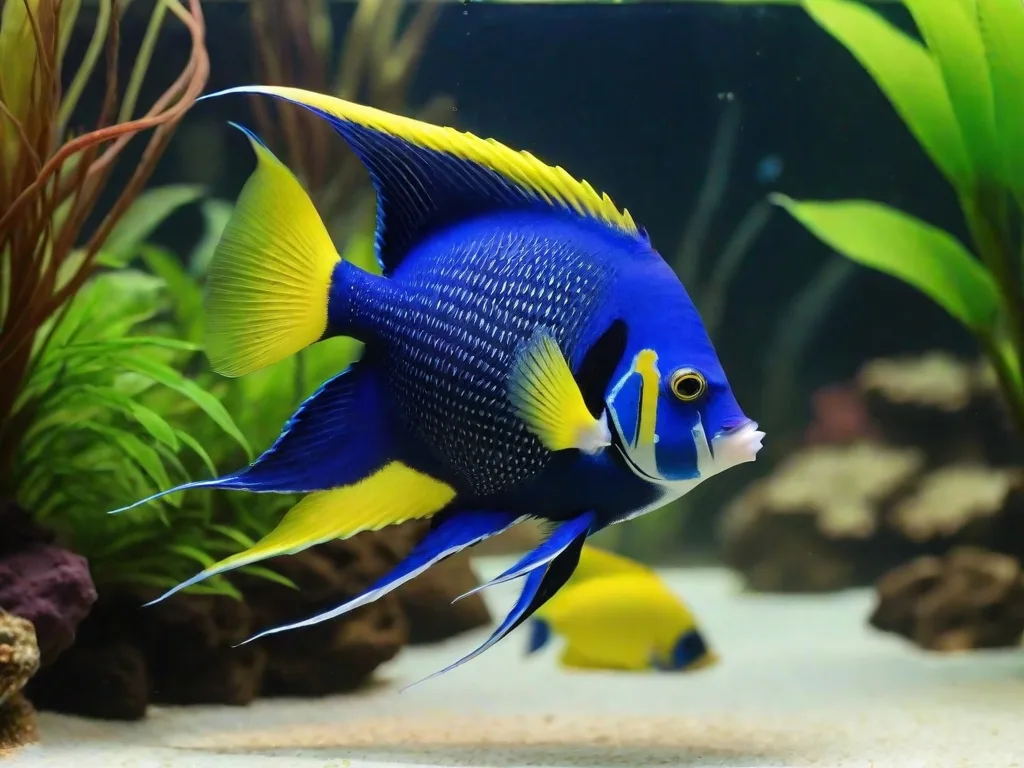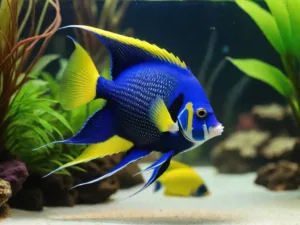While both angelfish and discus are popular freshwater aquarium fish, it’s essential to consider certain factors before keeping them together. Angelfish and discus have different care requirements, so compatibility depends on the specific conditions you provide in your tank.
Discus prefer warmer water temperatures, typically around 82-86°F (28-30°C), and they thrive in soft, acidic water. On the other hand, angelfish can tolerate a slightly broader range of temperatures and are adaptable to various water conditions.
To create a harmonious environment for both species, try to maintain a temperature around 80-82°F (27-28°C), which is suitable for both angelfish and discus. Additionally, provide slightly acidic to neutral water conditions.
It’s important to note that while some hobbyists successfully keep angelfish and discus together, there is always a risk of aggression or stress. Both species can be territorial during breeding or if they feel their space is being invaded.
Keep an eye on the behavior of the fish and be prepared to separate them if any signs of aggression or stress appear. Providing hiding spots, plants, and a well-structured tank layout can also help minimize potential conflicts.
In summary, with careful attention to water parameters and monitoring their interactions, it’s possible to keep angelfish and discus together in the same aquarium. Always be ready to make adjustments based on the behavior and well-being of the fish.
Can You keep angelfish and Discus together?
Angelfish and discus can coexist in the same tank, but successful cohabitation depends on certain considerations. Both species have their unique requirements, and providing a suitable environment is crucial for their well-being.
Here are some key factors to consider when keeping angelfish and discus together:
- Water Parameters: Discus thrive in warmer water with temperatures around 82-86°F (28-30°C), while angelfish prefer slightly cooler temperatures around 78-82°F (25-28°C). Aim for a compromise around 80-82°F (27-28°C) to accommodate both species. Additionally, maintain soft to moderately hard water with slightly acidic to neutral pH.
- Tank Size: Both angelfish and discus benefit from a spacious tank. A larger tank helps reduce territorial disputes and provides ample swimming space. Aim for a tank size of at least 55 gallons or more.
- Tank Setup: Create a well-structured tank with hiding spots, plants, and decorations. This helps in minimizing potential aggression and provides areas for fish to establish territories or retreat when needed.
- Compatibility: While some hobbyists successfully keep angelfish and discus together, individual personalities vary. Monitor their behavior closely, especially during feeding and breeding times. Be prepared to separate them if aggression or stress becomes an issue.
- Feeding: Ensure both species receive appropriate nutrition. Discus may have a more demanding diet, including high-quality pellets, frozen or live foods. Make sure the angelfish also receive a balanced diet suitable for their needs.
- Observation: Regularly observe the fish for signs of stress, aggression, or any health issues. If any problems arise, be prepared to take action promptly.
In conclusion, with careful planning and monitoring, it is possible to keep angelfish and discus together in a community tank. However, individual temperament and the specific conditions in your tank play crucial roles in determining the success of this combination.
What size tank is best to keep angelfish and discus
To provide a suitable environment for both angelfish and discus, it’s recommended to have a tank size of at least 75 gallons (around 283 liters) or larger. This size allows for enough swimming space and helps reduce territorial disputes between the fish.
Here are a few reasons why a larger tank is beneficial for keeping angelfish and discus together:
- Swimming Space: Both angelfish and discus are active swimmers, and a larger tank provides them with ample space to move around. This helps minimize stress and aggression.
- Territorial Behavior: Angelfish and discus can be territorial, especially during breeding or when establishing territories. A larger tank allows for the creation of distinct territories and reduces the likelihood of conflicts.
- Water Quality: In a larger tank, maintaining stable water parameters is generally easier. Consistent water quality is crucial for the health and well-being of both angelfish and discus.
- Aquascape Options: A larger tank provides more opportunities for creating a well-structured environment with hiding spots, plants, and decorations. This helps in minimizing stress and providing areas for fish to establish territories.
Remember that while a 75-gallon tank is a good starting point, larger tanks, such as 100 gallons or more, can further enhance the well-being of your fish. Additionally, regardless of tank size, diligent monitoring of the fish’s behavior, water parameters, and overall health is essential to ensure a harmonious coexistence between angelfish and discus.
Water Parameters
Maintaining ideal water parameters is crucial for the health and well-being of both angelfish and discus. Here are the recommended water parameters for these fish:
1. Temperature:
- Discus: 82-86°F (28-30°C)
- Angelfish: 78-82°F (25-28°C)
- Compromise for both: 80-82°F (27-28°C)
2. pH Level:
- Discus: Slightly acidic to neutral, ideally around 6.0-7.0
- Angelfish: Slightly acidic to neutral, around 6.5-7.5
3. Water Hardness (GH):
- Discus: Soft to moderately hard water, with a GH of 1-8 dGH
- Angelfish: Prefer slightly harder water, with a GH of 5-13 dGH
4. Ammonia, Nitrite, and Nitrate Levels:
- Keep ammonia and nitrite levels at 0 ppm.
- Nitrate levels should be kept below 20 ppm, ideally lower for discus.
5. Filtration:
- Provide efficient filtration to maintain water quality and remove waste.
6. Tank Size:
- A tank size of at least 75 gallons is recommended for keeping angelfish and discus together.
7. Water Changes:
- Regular water changes of 20-30% weekly are essential to maintain water quality.
8. Substrate:
- Use a substrate that is suitable for planted tanks, as plants can contribute to a stable environment.
9. Decorations and Hiding Spots:
- Include plants, driftwood, and other decorations to create hiding spots and territories.
By carefully monitoring and adjusting these parameters, you can create an environment that suits both angelfish and discus, promoting their health and reducing stress. Regular testing and observation of fish behavior will help ensure a successful and harmonious cohabitation.
Tank Mates for Angelfish And Discus
When choosing tank mates for angelfish and discus, it’s important to consider the specific needs and temperaments of each species. Here are some suitable tank mates that can coexist with angelfish and discus:
- Tetras: Many species of tetras, such as cardinal tetras or neon tetras, can be compatible with angelfish and discus. Ensure that the tetras are not too small to be considered as prey by angelfish.
- Corydoras Catfish: These bottom-dwelling catfish are generally peaceful and can tolerate the warmer water temperatures preferred by discus. Make sure the substrate is suitable for their barbels.
- Dwarf Cichlids: Some dwarf cichlid species, like German blue rams or Apistogramma, can cohabit with angelfish and discus. Keep an eye on their interactions to ensure compatibility.
- Gouramis: Certain gourami species, such as honey gouramis, can be compatible. Avoid aggressive gourami species that might cause stress.
- Loaches: Peaceful loach species like the clown loach may be suitable, but be cautious with larger loaches that could potentially harass discus.
- Rasboras: Harlequin rasboras and other peaceful rasbora species can make good tank mates. Ensure they are not too small to be seen as prey.
- Rainbowfish: Some rainbowfish species, like Bosemani or turquoise rainbows, can coexist in a community tank with angelfish and discus.
- Guppies and Platies: These small, colorful fish can add variety to the tank, but be cautious with breeding, as angelfish may eat the fry.
It’s essential to monitor the interactions between tank mates and be prepared to make adjustments if any aggression or compatibility issues arise. Additionally, providing plenty of hiding spots, plants, and a well-structured tank can help reduce stress and territorial behaviors. Always research the specific needs and behaviors of each species to ensure a harmonious community.











